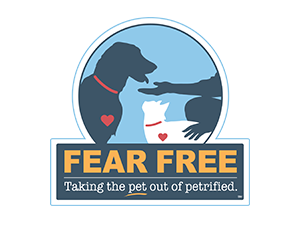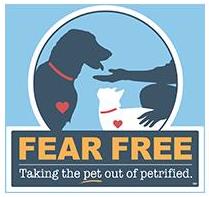
January 2019 – Pet Health and Safety Tips during Frigid Weather
Cold weather can be just as threatening to a pet’s health as hot weather. We’ve gathered some tips offered by the American Veterinary Medical Association, and following is what you need to know to keep your pets healthy through the coldest of days and long winter nights.
Existing medical conditions: Cold weather may worsen some medical conditions such as arthritis. Pets with diabetes, heart disease, kidney disease, or hormonal imbalances (such as Cushing’s disease) may have a harder time regulating their body temperature, and may be more susceptible to problems from temperature extremes. Make sure you alert your veterinarian of any unusual or worsening symptoms. An exam may be in order, and therapy and/or medications may be prescribed to help your pet feel better during the cold winter months
Pets have limits: Cold tolerance can vary from pet to pet based on their coat, body fat stores, activity level, and health. Very young and very old pets may become uncomfortable more quickly in frigid weather. Therefore, make some adjustments such as shortening your dog’s outdoor walks on very cold days. Be mindful of ice and snow and notice any difficulty your pet experiences navigating the terrain. You don’t want your pet to experience an unnecessary fall.
If your pet is whining, shivering, seems anxious, slows down or stops moving, seems weak, or starts looking for warm places to burrow, get them back inside quickly because these are signs of hypothermia. Frostbite is harder to detect, and may not be fully recognized until a few days after the damage is done. If you suspect your pet has hypothermia or frostbite, consult your veterinarian immediately. It’s best just to stay inside on the most frigid of days and put your pet’s health at risk.
During your walk, check your dog’s paws frequently for signs of cold-weather injury or damage, such as cracked paw pads or bleeding. A sudden lameness may be due to an injury or may be due to ice accumulation between his/her toes. You may be able to reduce the chance of ice ball accumulation by clipping the hair between your dog’s toes.

Make sure your pet has a well-fitting collar with current identification and contact information. A microchip is a more permanent means of identification, but it’s critical that you keep the registration up to date. Many pets become lost in winter because snow and ice can hide recognizable scents that might normally help your pet find his/her way back home.
Coats and Sweaters: Long-haired or thick-coated dogs tend to be more cold-tolerant, but are still at risk in cold weather. Short-haired pets feel the cold faster because they have less protection, and short-legged pets may become cold faster because their bellies and bodies are more likely to come into contact with snow-covered ground.


If your dog has a short coat or seems bothered by the cold weather, consider a sweater or dog coat. Have several on hand, so you can use a dry sweater or coat each time your dog goes outside. Wet sweaters or coats can actually make your dog colder. Some pet owners also use booties to protect their dog’s feet; if you choose to use them, make sure they fit properly and give your pet time to adjust. Some animals resist wearing booties on their feet and need some time to walk confidently.
Poisoning alert: Clean up any antifreeze spills in your own driveway or parking lot quickly – even small amounts of antifreeze can be deadly to an animal. During walks, your dog’s feet, legs and belly may pick up deicers, antifreeze, or other chemicals on the sidewalks and ground that could be toxic. Be sure to wipe down or wash your pet’s feet, legs and belly to remove these chemicals after your walk to eliminate the risk of poisoning when your pet licks his/her feet or fur. Consider using pet-safe deicers on your property to protect your pets and the others in your neighborhood.
Sleeping choices: You may notice your pet changing their sleeping habits in your home during the cold days and nights – they may change their location based on their need for more or less warmth. Give them some safe options to allow them to vary their sleeping place to adjust to their needs.
Check under the car hood before starting your engine: Outdoor, feral, and stray cats seek warmth as the temperature plummets and sometimes climb into a car’s warm engine area. Be sure to check underneath your car, bang on the hood, and honk the horn before starting your engine to scare off a resting feline. A vehicle engine can be an appealing heat source for outdoor and feral cats, but it’s a potentially deadly resting place.
Leave your pet at home: Hot cars are a known threat to pets, but cold cars also pose significant risk to your pet’s health. A car cools rapidly and can feel like a refrigerator, rapidly chilling a pet left inside. Pets that are young, old, ill, or thin are particularly susceptible to cold environments and should never be left in cold cars. Limit car travel to only that which is necessary, and never leave your pet unattended in the vehicle.
Recommended Reading:
Keep your dog safe with a secure collar and proper identification
Belle Mead Animal Hospital, Your Other Family Doctors
Handling Every Pet with Love Every Day!
As Certified Fear Free Professionals, our Mission is to prevent and alleviate fear, anxiety and stress in pets by inspiring and educating the people who care for them.


LIKE us on Facebook and Follow us on Twitter @BMAH121, Pinterest and Google+ for news and pet wellness tips. We’re also on YouTube! Subscribe for updates! Tag us on Instagram!








